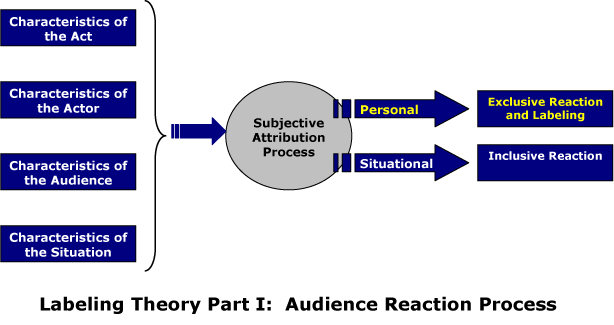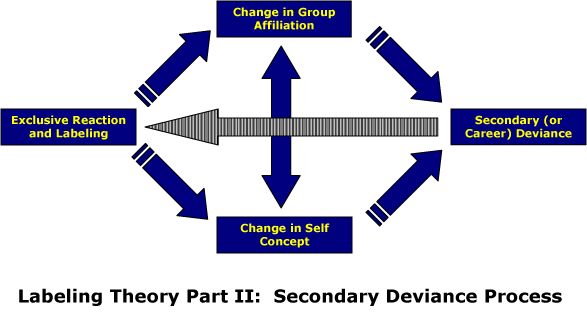

Theories of Deviant Drinking5. Micro-Relativistic: Labeling Theory |
The beginnings of the relativistic perspective on deviance go back a number of years. However, a serious challenge to the dominant normative perspective did not develop until the early 1960s, when several important micro-relativistic analyses of deviance were published. The best known of these theoretical statements is contained in Howard Becker’s book, Outsiders (1963). The term labeling theory comes from Becker’s relativistic definition of deviance (1963: 9):
[D]eviance is not a quality of the act the person commits, but rather a consequence of the application by others of rules and sanctions to an “offender.” The deviant is one to whom that label has successfully been applied; deviant behavior is behavior that people so label.
In other words, it is not what you do that makes you deviant; it depends on how other people label you. Although Becker’s book devotes some attention to macro-level problems, such as the influence of powerful interest groups on anti-marijuana legislation, his greatest contribution is an insightful analysis of the micro-level implications of the labeling of individual deviants.
Becker argues that deviance theory should be concerned with dynamic interactional processes rather than cause-and-effect relationships between static variables (1963: 23): “all causes do not operate at the same time, and we need a model which takes into account the fact that patterns of behavior develop in an orderly sequence.” He suggests the concept of “career” as a useful model for labeling theory. This concept is applied in Outsiders in an analysis of the steps and contingencies involved in the development of a deviant career—a stable pattern of deviant behavior which is an outcome of labeling processes.
Becker points out that many people occasionally commit nonconforming acts without becoming involved in a sustained pattern of deviant activity. The main reason for this is that most people do not get caught in their nonconformity and remain “secret deviants.” One of the most important steps in the process of involvement in a deviant career, according to Becker, is “the experience of being caught and publicly labeled as deviant” (1963: 31). No matter who the person was before being labeled, others’ reactions to this person now become focused on one overwhelming aspect of his or her identity—the label or deviant status of drunk, dope fiend, nut, etc.
As a result of these reactions, one of the next steps in the developing deviant career is that “one tends to be cut off. . . from participation in more conventional groups” (1963: 34). A person who has been labeled as an alcoholic or a drug addict, for instance, may be denied employment in a “respectable” job and subsequently “drift into unconventional, marginal occupations where it does not make so much difference” to be this kind of deviant (1963: 34). In fact, the deviant may have no choice but to enter into the very kinds of pursuits typically expected of such a person—deviant activities.
The final stages of the deviant career come with the person’s increasing involvement with others who have been similarly labeled in organized deviant groups. Membership in a deviant group confirms one’s self-identity as the kind of deviant he or she has been labeled. For instance, a person who has been labeled as a "drunk" or "alcoholic" might increasingly hang out with other drinkers and become one of the "regulars" at a particular bar or street corner. In addition, members of such groups share a deviant subculture, “a set of perspectives and understandings about what the world is like and how to deal with it” (1963: 38). This subculture provides the deviant with rationalizations and justifications for further deviant activity. Thus, the deviant who eventually ends up in an organized deviant group and shares in its subculture “is more likely than ever before to continue in his ways” (1963: 39).
Becker’s analysis gives us a dynamic account of how a person can be funneled into a deviant career by labeling processes. This is also a compellingly humanistic theory of deviance. We can identify and sympathize with the deviant who has been the victim of labeling processes, even to the extent of realizing that it could happen to any of us. In this and many other respects, Becker’s micro-relativistic approach to deviance theory contrasts markedly with normative theories that emphasize in a detached, “objective” way the fundamental differences between deviants and nondeviants. If Becker makes us understand the human implications of reactions to deviance, then he has accomplished one of his major theoretical goals.
In general, labeling (or social reaction) theorists focus on two related, but distinct processes through which deviant meanings become attached to actors and behaviors. First, most labeling theorists argue that the phenomenon of "deviance" is interactionally created through a complex process of audience reaction to an act or actor in a given social situation. The basic elements in this process are depicted below as Part I of labeling theory. When social audiences encounter troublesome behavior and people, characteristics of the act, the actor, the audience, and the situational context jointly influence the audience's subjective interpretation or causal attribution of the source of the "problem." Does the audience interpret the problem as an expression of personal attributes of the actor (such as a genetic flaw or a chronic mental disorder) or is the problem attributed to situational circumstances or pressures? Personal attributions tend to result in exclusive reactions, such as rejection of the actor from conventional groups, and labeling of the actor as deviant. For example, this would be the case when a family can no longer deal with a "hopeless drunk" and terminate their relationship. On the other hand, situational attributions generally lead to inclusive reactions aimed at modifying the actor's troublesome behavior without excluding him or her from conventional group relationships. Families may spend years trying to persuade a problem drinker who is "simply under stress" to alter his or her behavior. A crucial issue for research and treatment of alcohol problems is understanding the dynamics of labeling and audience reaction to deviant drinkers in the family and in other social relationships.
 |
|
|
Most
versions of labeling theory also direct attention to a second social process--secondary
deviance--that flows from the experience of labeling and exclusion
from conventional group relationships. Actors who have been socially labeled
as deviant may change their group affiliation and begin to associate with
others who have been similarly labeled. Furthermore, the actor might undergo
change in self concept as a result of the labeling experience and begin
to identify with the deviant label. As a result of these interrelated
transformations in the actor's social relations and personal identity,
the actor might become committed to a stable pattern of secondary
(or "career") deviance that is the product of the
labeling experience. This sustained pattern of deviant activity, in turn,
might lead back to continued labeling and rejection by conventional audiences. For instance, the disease model of alcoholism ("once an alcoholic, always an alcoholic") might actually undermine recovery by locking a problem drinker into a deviant self-image and a career of uncontrolled drinking.
|
|
 |
|
| Previous Page | Index Page |